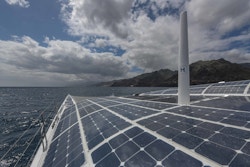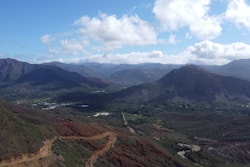What potential for natural hydrogen?
The different means of hydrogen production are often linked to a colour, this palette enables a rapid understanding of where the hydrogen comes from and what carbon footprint is associated to its production. Although hydrogen is the most abundant element in the universe, it rarely exists in pure form, and is generally combined with other atoms. The exception is White hydrogen, which was thought to be rare, but whose potential is being uncovered now.

Energy Observer in Tenerife
The colours of hydrogen (preferably green)
Hydrogen is known to come in a variety of different colours – Black, Grey, Green, Blue, Turquoise, Pink or Yellow – depending on its mean of production. Green hydrogen, for example, is produced from electrolysis of the water molecule using electricity from renewable sources, like solar or wind power. This is how we produce hydrogen on board Energy Observer; thanks to the electricity produced by our solar panels, we split the molecule of purified water that we pump and desalinise straight from the sea.
Grey hydrogen however, is produced from natural gas, where the hydrogen is separated from the carbon atoms using water vapour (a technique called steam reforming). This widely used method, however, emits about 9.3 kg of CO2 for 1kg of hydrogen.
The emissions resulting from steam reforming can be captured and sequestered, making the production “low carbon”, and this is what Blue hydrogen refers to (for the meaning of the other hydrogen colours, please refer to the table below).
In the end, the hydrogen molecule is the same, but the means of production will determine the global carbon impact of a hydrogen energy system.
Natural hydrogen sources in New Caledonia
In New Caledonia, where the Energy Observer ship is currently moored, we can find White hydrogen, the naturally occurring hydrogen. This type of hydrogen is not created by humans, but is found in its natural form, as a free gas, either in layers of the continental crust, deep in the oceanic crust, in volcanic gases, in geysers or in hydrothermal systems. Hydrogen seems to be present in a wide range of rock formations and geological regions.
The natural processes of hydrogen creation are not yet fully understood. Some hypotheses include degassing of hydrogen directly from the Earth’s core, reaction of water with ultrabasic rocks (serpentinization*) or reducing agents in the mantle, natural radiolysis (dissociation of water by uranium or plutonium), and decomposition of organic matter. In New Caledonia, the proposed origin of the gas is the serpentinization, where water reacts with certain rocks (here ophiolites) and release its hydrogen. The Neo-Caledonian source is located in the Prony Bay, in the lagoon, where underwater vents release warm (43˚C) and alkaline (pH>11) waters rich in H2 (between 12 and 34%).
A resource that is difficult to identify
Once considered a rare occurrence as a free gas, recent comprehensive reviews show that hydrogen is in fact much more widespread in nature than previously thought. The misconception of free hydrogen being rare can be explained in various ways. Firstly, if no one expects to find free hydrogen, no one samples for it. And this is why, even today, sensor systems and analysing technics are not that good at detecting hydrogen. Another factor, hindering natural hydrogen discovery, is the fact that most wells around the world have been drilled in sedimentary layers, where oil and other fossil energy sources are found. However, these rocks are not the most likely places for hydrogen to be abundant. Lastly, hydrogen being the lightest element on earth, it diffuses rapidly in air and other environments and cannot be retained in geological traps for long periods of time.
Unlike fossil fuel stocks that require millions of years to form, natural hydrogen is created continuously, with a timeframe for renewal that is about the length of a human life.
Where hydrogen becomes an energy source (and not only a vector)
Natural hydrogen, with its continuous production and short retention period, should thus be considered as a flux rather than a stock. A very dynamic system that could expaend our use of hydrogen today, where this precious gas could be seen as a source of energy and not only as a vector of energy. This is demonstrated in Mali, where a 98% purity hydrogen vent is being directly exploited. The gas is burnt inside a turbine to create electricity, which is used to power the village of Bourakébougou.
Today, 95% of man-made hydrogen comes from steam reforming, a technique with a great efficiency, but a disastrous carbon footprint. On the other hand, electrolysis creates hydrogen from renewable energies, but loses about two thirds of the energy input in the production process. Natural hydrogen is now being seen as a promising carbon-free and abundant energy-source that requires minimal infrastructures for its exploitation (far from the requirements of oil wells). Due to the lack of dedicated research thus far, it is hard to evaluate the white hydrogen resources in the world. But since march 2021, the initiative EarthH2 is helping scientists and industrialists join forces and together increase the current knowledge on the topic of natural hydrogen. A hydrogen future in white and green could help us transition to carbon-free energies, for the better of the earth and mankind.
* Serpentinization is a natural alteration process of rocks, containing a high concentration of iron and magnesium, by water. This alteration, combined with the oxidation of the metals present in the rocks, produces a hydrogen-rich gas and a very alkaline water (pH up to 12,5).
Example of serpentinization in olivine (a mineral rich in iron and magnesium)
3 Fe2SiO4 + 2 H2O –> 2 Fe3O4 + 3 SiO2 + 2 H2
Fayalite + Water –> Magnetite + Silica + Hydrogen
To go further: the various means of hydrogen production
- Grey
Production by steam reforming. Natural gas, mainly methane (CH 4), reacts with water vapour in a high-pressure mixture to produce carbon dioxide and hydrogen.
CH4 + H2O –> CO + 3 H2
then
CO + H2O –> CO2 + H2
- Green
Hydrogen can also be created by electrolysis of water. This is when electricity is used to split the molecule of water into oxygen and hydrogen.
Green or “clean” hydrogen means that the electricity used to electrolyse water comes from renewable sources (solar, wind, geothermal etc.).
- Blue
Hydrogen is called Blue when it has been produced by steam reforming, but CO2 emissions have been captured and sequestered to avoid their release into the atmosphere.
- Black/Brown
By transformation of coal into gas. Coal is heated at 700˚C (without combustion) and oxygen and/or water vapour is added. The mix of carbon monoxide (CO) and water vapour is transformed into carbon dioxide (CO2) and hydrogen. This is called gasification.
CO + H2O –> CO2 + H2
- Turquoise
Methane can also be split at very high temperatures in a process called methane pyrolysis. With this technique, hydrogen is released as a gas and carbon as a solid. Solid carbon can be sequestered easily or reused in different forms. This process is also “low carbon” because CO2 is not released into the atmosphere.
- Pink
When the electricity for electrolysis comes from nuclear power.
- Yellow
When the electricity for electrolysis comes from a mix of renewable (solar) and non-renewable power.

